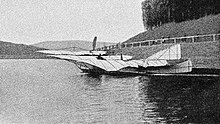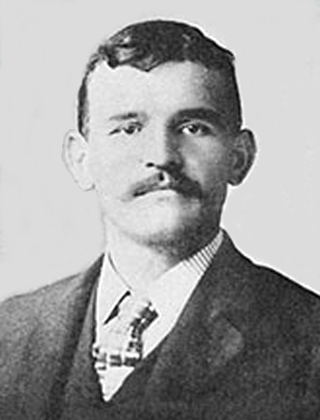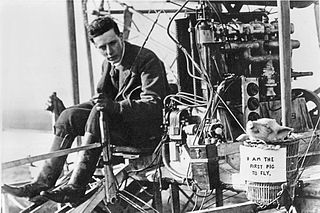This is a list of aviation-related events from 1901:
This is a list of aviation-related events from 1901:




The Wright brothers, Orville Wright and Wilbur Wright, were American aviation pioneers generally credited with inventing, building, and flying the world's first successful motor-operated airplane. They made the first controlled, sustained flight of a powered, heavier-than-air aircraft with the Wright Flyer on December 17, 1903, 4 mi (6 km) south of Kitty Hawk, North Carolina, at what is now known as Kill Devil Hills. The brothers were also the first to invent aircraft controls that made fixed-wing powered flight possible.
This is a list of aviation-related events from 1903:

Octave Chanute was a French-American civil engineer and aviation pioneer. He advised and publicized many aviation enthusiasts, including the Wright brothers. At his death, he was hailed as the father of aviation and the initial concepts of the heavier-than-air flying machine.

Gustave Albin Whitehead was an aviation pioneer who emigrated from Germany to the United States where he designed and built gliders, flying machines, and engines between 1897 and 1915. Controversy surrounds published accounts and Whitehead's own claims that he flew a powered machine successfully several times in 1901 and 1902, predating the first flights by the Wright Brothers in 1903.
This is a list of aviation-related events from 1911:

This is a list of aviation-related events from 1909:
This is a list of aviation-related events from 1908:
This is a list of aviation-related events from 1904:
This is a list of aviation-related events during the 19th century :

The Wright Flyer made the first sustained flight by a manned heavier-than-air powered and controlled aircraft—an airplane—on December 17, 1903. Invented and flown by brothers Orville and Wilbur Wright, it marked the beginning of the pioneer era of aviation.
The Wright Flyer III was the third powered aircraft by the Wright Brothers, built during the winter of 1904–05. Orville Wright made the first flight with it on June 23, 1905. The Flyer III had an airframe of spruce construction with a wing camber of 1-in-20 as used in 1903, rather than the less effective 1-in-25 used in 1904. The new machine was equipped with the engine and other hardware from the scrapped Flyer II and, after major modifications, achieved much greater performance than Flyers I and II.

The Wright Flyer II was the second powered aircraft built by Wilbur and Orville Wright. During 1904 they used it to make a total of 105 flights, ultimately achieving flights lasting five minutes and also making full circles, which was accomplished by Wilbur for the first time on September 20.

The Wright brothers designed, built and flew a series of three manned gliders in 1900–1902 as they worked towards achieving powered flight. They also made preliminary tests with a kite in 1899. In 1911 Orville conducted tests with a much more sophisticated glider. Neither the kite nor any of the gliders were preserved, but replicas of all have been built.

Katharine Wright Haskell was the younger sister of aviation pioneers Wilbur and Orville Wright. She worked closely with her brothers, managing their bicycle shop in Dayton, Ohio, when they were away; acting as their right-hand woman and general factotum in Europe; assisting with their voluminous correspondence and business affairs; and providing a sounding board for their far-ranging ideas. She pursued a professional career as a high school teacher in Dayton, at a time when few middle-class American women worked outside the home, and went on to become an international celebrity in her own right. A significant figure in the early-twentieth-century women’s movement, she worked actively on behalf of woman suffrage in Ohio and served as the third female trustee of Oberlin College.

History by Contract is a 1978 book by early aviation researchers Major William J. O'Dwyer, U.S. Air Force Reserve (ret.) and Stella Randolph about aviation pioneer Gustave Whitehead. The book focuses on a 1948 agreement between the Smithsonian Institution and the estate of Orville Wright, which stipulates that the Smithsonian, as a condition of owning and displaying the 1903 Wright Flyer, must recognize and label it as the first heavier-than-air machine to make a manned, powered, controlled and sustained flight.

Henri Deutsch de la Meurthe, born Salomon Henry Deutsch, was a successful French petroleum businessman, and a supporter of early aviation. He sponsored a number of prizes to encourage the development of aviation technologies, including the Grand Prix d'Aviation and the Deutsch de la Meurthe prize.

The Wright Model E was the first in the series of Wright Flyers that used a single propeller The aircraft was also the test demonstrator for the first automatic pilot control.
Tom Day Crouch is an American aeronautics historian and curator.
Several aviators have been claimed as the first to fly a powered aeroplane. Much controversy has surrounded these claims. It is generally accepted today that the Wright brothers were the first to achieve sustained and controlled powered flight. Brazil claims its own native citizen Alberto Santos-Dumont as the first successful aviator, discounting the Wrights because their Flyer took off from a rail and would sometimes even employ a catapult. An editorial in the 2013 edition of Jane's All the World's Aircraft supported the claim of Gustave Whitehead. Claims by, or on behalf of, other pioneers such as Clement Ader have also been put forward from time to time.